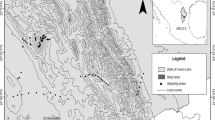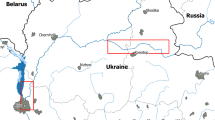Abstract
The ruderal communities of the orders Sisymbrietalia and Onopordetalia from the western part of Slovakia have been subjected to numerical classification and ordination. The ordination techniques proved to be a useful tool in the elucidation of the cluster pattern as well as in the detection of the main environmental variation underlying the floristic variation within the data. Results obtained with numerical techniques and traditional syntaxonomical classification have been compared. The similarity between these results is low at the level of the orders. This incompatability is explained by the differences in the weighting of the species in the course of the classification process and by the addition of non-floristical criteria that often occurs in syntaxonomical classification according to Braun-Blanquet. The highest value has been observed at the 3-clusters level (both orders and the Malvion neglectae). High similarity among the results of the numerical techniques have been observed, particularly in the group of space-dilating clusterings (Ward's method, Complete linkage clustering and MeQuitty's similarity analysis). Average linkage clustering produces the most diverse result. The Malvion neglectae appeared as a separate group in all numerical techniques adopted. This suggests the upranking of its syntaxonomical position. The Bromo-Hordeion murini turned out to be a very heterotoneous syntaxon.
Similar content being viewed by others
References
Braun-Blanquet J., 1964. Pflanzensoziologie. Grundzüge der Vegetationskunde. 3. Aufl. Springer, Wien, New York. 865 pp.
Coetzee B. J. & Werger M. J. A., 1973. On hierarchical syndrome analysis and the Zürich-Montpellier table method. Bothalia 11: 159–164.
Ehrendorfer F. (ed.) et al. 1973. Liste der Gefässpflanzen Mitteleuropas. 2. Aufl. Gustav Fischer, Stuttgart. 318 pp.
Goldstein R. A. & Grigal D. F., 1972. Computer programs for the ordination and classification of ecosystems (ORNL-IBP-71–10). Oak Ridge National Laboratory, Oak Ridge, Tennessee.
Goodman L. A. & Kruskal W. H., 1954. Measures of association for cross classifications. J. Am. Stat. Ass. 49: 732–764.
Grigal D. F. & Ohmann L. F., 1975. Classification, description, and dynamics of upland plant communities within a Minnesota wilderness area. Ecol. Monogr. 45: 389–407.
Hill M. O., 1979. DECORANA. A Fortran program for detrended correspondence analysis and reciprocal averaging. Ecology and Systematics, Cornell University, Ithaca. 52 pp.
Hill M. O., 1973. Reciprocal averaging: An eigenvector method of ordination. J. Ecol. 61: 237–249.
Hill M. O. & Gauch H. G.Jr., 1980. Detrended correspondence analysis: An improved ordination technique. Vegetatio 42: 47–58.
Hogeweg P., 1976. Iterative character weighting in numerical taxonomy. Comput. Biol. Med. 6: 199–211.
Holgate P., 1971. Notes on the Marczewski-Steinhaus coefficient of similarity. In: G. P. Patil, E. C. Pielou & W. E. Waters (eds.). Many species populations, ecosystems, and system analysis. Statist. Ecol. Ser. 3: 181–193. Pennsylvania State University, Pennsylvania.
Lance G. N. & Williams W. T., 1967. A general theory of classificatory sorting strategies. 1. Hierarchical systems. Comput. J. 9: 373–380.
Maarel E. van der, 1975. The Braun-Blanquet approach in perspective. Vegetatio 30: 213–219.
Maarel E. van der, 1980. On the interpretability of ordination diagrams. Vegetatio 42: 43–45.
Maarel E. van der (ed.), 1980. Classification and ordination. Advances in vegetation science, Vol. 2. Dr. W. Junk, The Hague. 188 pp. (Vegetatio, Vol. 42).
Mucina L., 1981. Die Ruderalvegetation des nördlichen Teils der Donau-Ticfebene. 1. Onopordion acanthii-Verband. Folia Geobot. Phytotax. 16: 225–263.
Mucina, L., 1982. Všcobecná charakteristika ruderálnej vegetácie severozápadnej časti Podunajskej ni ziny. (General characteristic of the ruderal vegetation in the northwestern part of Podunajská ni zina Lowlands (Slovakia)). Preslia 54 (in press).
Orlóci L., 1967. An agglomerative method for classification of plant communities. J. Ecol. 55: 193–205.
Orlóci L., 1978. Multivariate analysis in vegetation research. 2nd ed. Dr. W. Junk, The Hague. 451 pp.
Pielou E. C., 1977. Mathematical ecology, 2nd ed., John Wiley & Sons, Chichester, Now York, Brishane, Toronto. 396 pp.
Popma, J., Tongeren, O. van, Mucina, L. & Maarel, E. van der, 1982. On the determination of optirnal levels in phytosociological classification. Vegetatio (submitted).
Prichard N. M. & Anderson A. J. B., 1971. Observations on the use of cluster analysis in botany with an ecological example. J. Ecol. 59: 727–747.
Rohlf F. J., 1974. Methods of comparing classifications. Ann. Rev. Ecol. Syst. 5: 101–113.
Roskam, E., 1971. Programme ORDINA: Multidimensional ordination of observation vectors. Programme Bull. 16, Psychology Lab., University of Nijmegen. 8 pp.
Sneath P. H. A. & Sokal R. R., 1973. Numerical Taxonomy. Freeman, San Francisco. 573 pp.
Stanek W., 1973. A comparison of Braun-Blanquet's method with sum-of-squares agglemeration for vegetation classification. Vegetatio 27: 323–345.
Ward J. H., 1963. Hierarchical grouping to optimise an objective function. J. Am. Stat. Ass., 58: 236–244.
Westhoff V. & Maarel E. van der, 1978. The Braun-Blanquet approach. In: R. H. Whittaker (ed.), Classification of plant communities, p. 287–399. Dr. W. Junk, The Hague.
Westhoff V., 1967. Problems and use of structure in the classification of vegetation. Acta Bot. Neerl. 15: 495–511.
Whittaker R. H., 1972. Convergence of ordination and classification. In: E. van der Maarel and R. Tüxen (eds.), Basic problems and methods in phytosociology. Ber. Int. Symp. Rinteln 1970, p. 39–57, Dr. W. Junk, The Hague.
Wishart, D., 1978. CLUSTAN 1C. User manual. 3rd. ed. Inter-University Research Council Series. Report 47. 175 pp.
Author information
Authors and Affiliations
Additional information
The nomenclature of species follows Ehrendorfer et al. (1973).
I am indebted to Prof. Dr. Eddy van der Maarel, Uppsala and Prof. Dr. M. J. A. Werger, Utrecht for careful revision of the manuscript and to Drs. Onno van Tongeren and Mr. Jean Popma for their help and advice. All the computations have been performed in the University Computer Centre at Nijmegen. I would like to thank Mr. Henry Moreton, M.Sc. for linguistic revision of a part of the manuseript.
Recipient of the Research Fellowship in Biology 1980/1981 at the University of Nijmegen, The Netherlands.
Rights and permissions
About this article
Cite this article
Mucino, L. Numerical classification and ordination of ruderal plant communities (Sisymbrietalia, Onopordetalia) in the western part of Slovakia. Vegetatio 48, 267–275 (1982). https://doi.org/10.1007/BF00055270
Accepted:
Published:
Issue Date:
DOI: https://doi.org/10.1007/BF00055270




